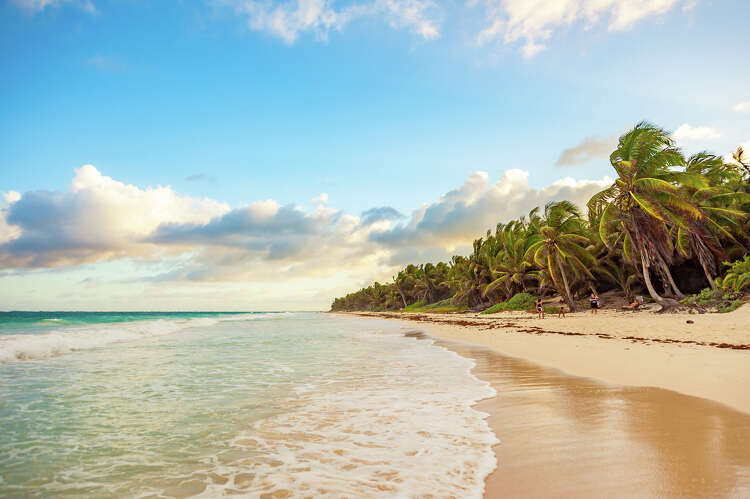A New Era for Tulum’s Coastal Landscape
A new chapter is unfolding along the coastline of Tulum, Mexico. With the late 2024 opening of Parque del Jaguar—also known as Jaguar National Park—a stretch of once loosely regulated beachfront has been transformed into a protected zone featuring forest trails, Maya ruins, and serene beachfront areas. Spanning over 2,400 acres, this park marks a significant shift from the noise and congestion that have become synonymous with much of Tulum’s rapid growth. Within the reserve, the pace of life slows down considerably. Cars are limited in number, beach vendors are no longer allowed, and the usual buzz of tourism gives way to the sounds of birdsong and crashing waves.
Jaguar encircles the well-known Tulum Archaeological Zone and extends deep into the surrounding forest. It is now governed by new regulations that prohibit the use of plastic, restrict commercial vendors, and limit the number of daily visitors. Entry requires a ticket, which is included for overnight guests at the park’s on-site hotels. Rangers are stationed at key checkpoints to guide visitors and enforce the rules, ensuring that the natural and cultural heritage of the area is preserved.
The primary goal of the park is twofold: to restore and conserve the land and to change the way travelers experience one of Mexico’s most visited regions. Known for its booming beach club scene, Tulum is now home to one of the Yucatán Peninsula’s most ambitious conservation projects.
“It already felt like a national park even before it was designated,” said Maya Andrade, general manager of the onsite boutique hotel Mezzanine Tulum. “But we had no idea how much would change.”
Mezzanine is one of a small handful of hotels that have been officially grandfathered into Jaguar and are allowed to continue operating within the protected zone under long-standing permits. No new hotels are permitted inside the park boundaries, and development is heavily restricted. Guests staying at Mezzanine have the rare opportunity to wake up inside the reserve with direct access to the beach, archaeological sites, and forest trails.
When Mezzanine opened its doors more than 20 years ago, Tulum was still off the radar for most international travelers. The coast was lined with a few basic beachfront cabanas catering to budget-conscious visitors. Electricity was limited, roads were unpaved, and accommodations were often no more than wooden huts with mosquito nets.
“Everything was so, so rustic,” Andrade said. “It was just little cabañitas that attracted backpacker-types.”
From the beginning, Mezzanine set itself apart. The boutique hotel offered nine rooms blending an eco-conscious design aesthetic with indoor-outdoor living, plus a level of service that hadn’t yet arrived in this part of Mexico. As Tulum shifted from a backpacker haven to a destination for high-end travelers, including celebrities and foodies, Mezzanine adapted alongside it. One of the turning points came when the acclaimed Denmark restaurant Noma held a pop-up just down the beach, putting Tulum on the map for global food media. Once the pandemic hit in 2020, Tulum saw another wave of visitors. This time the influx brought digital nomads, influencers, more celebrities, and wellness retreat travelers to town.
Now, Jaguar repositions Tulum as a destination for slow exploration. Those staying inside the park can spend their days biking between ruins and reef-lined beaches, visiting the museum, or sipping margaritas by the pool.
The Heart of the Park: Tulum’s Archaeological Zone
The centerpiece of the park is the archaeological zone. The collection of temples and pre-Hispanic buildings sits on a coastal cliff at the park’s eastern edge. The ancient city, with panoramic ocean views, was once a busy port with walls guarding its ceremonial center and steep steps leading down to the beach.
The most iconic structure in Tulum’s archaeological zone is the 26-foot temple El Castillo. Originally used as a lighthouse by Maya sailors, its small upper windows would glow with firelight to guide canoes safely to shore. While El Castillo is smaller in scale than Chichén Itzá, few Maya sites can match the setting of temples perched on cliffs overlooking the turquoise blue water of the Caribbean Sea.
Expanding the Experience
Elsewhere in the park, trails wind through secondary forest and newly planted native trees. The site of a former airfield is now being reforested, and there are plans to connect a network of lookouts, interpretive centers, and shaded paths to the Tren Maya station nearby. A museum dedicated to the region’s Maya heritage has already opened near the entrance. Stone carvings, architectural masks, and jade jewelry are among some of the artifacts that, along with educational displays and rotating exhibits, offer insight into the Maya culture.
While the long-term plan is still unfolding, the early results are visible. The beaches inside Jaguar National Park are among the quietest in the area thanks to the ban on sound systems, vendors, and public access for anyone who hasn’t entered through the front gate. Wildlife sightings are becoming more common—coatis, toucans, even the occasional jaguarundi—and the pace is more relaxed without the steady stream of taxis and motorbikes. In a town known for rapid development and fleeting trends, Jaguar shifts the focus from what is new to what is worth protecting.



